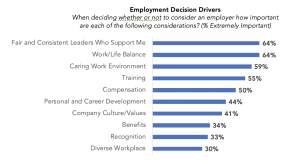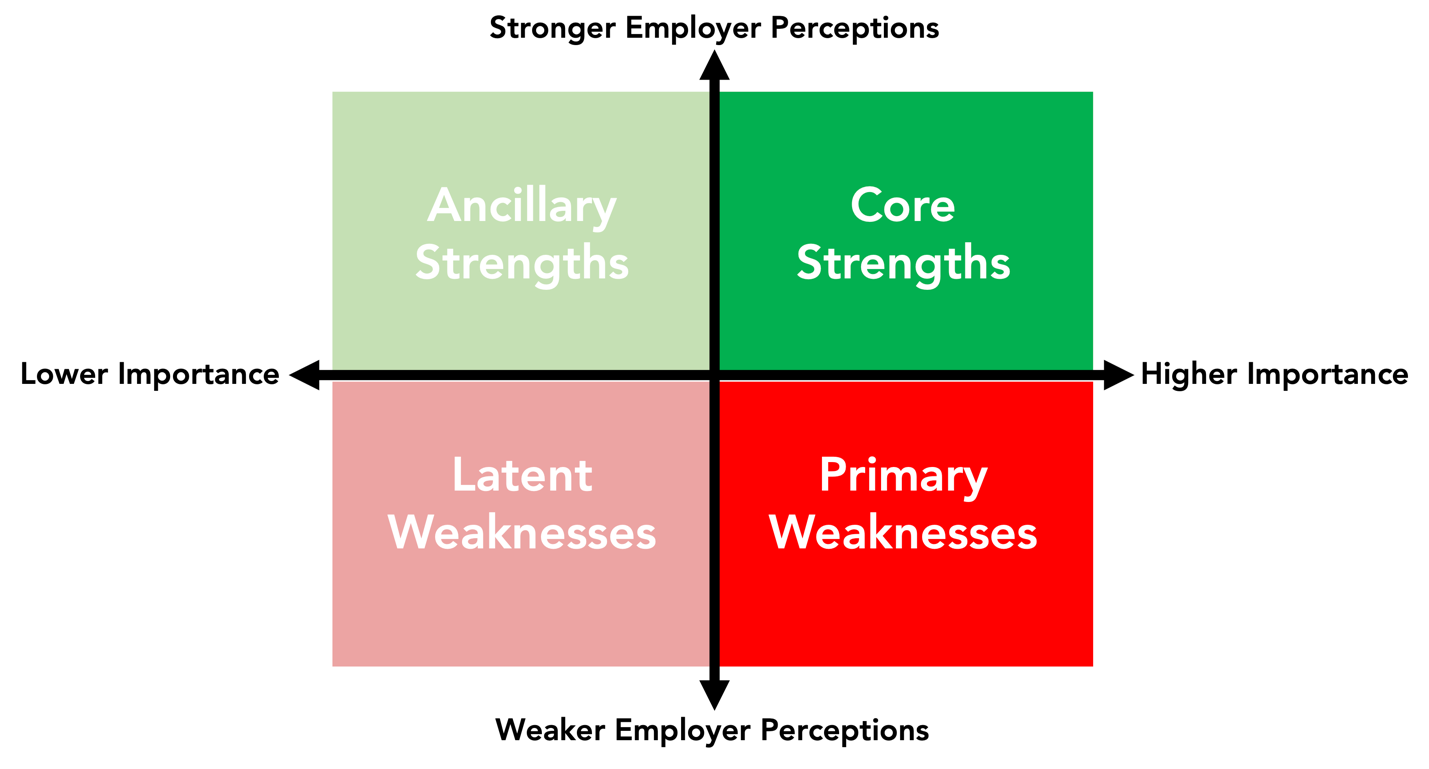If you’re serious about investing in your employer brand — which, of course, you should be — defining your value prop is an important first step. Yet it’s not always easy to know where to begin. Definitions and approaches vary, but at its core, a good EVP should concisely answer this fundamental question: Why should people want to work for you?
Sounds simple enough, but in practice, things can get complicated very quickly.
To start, the sheer number of audiences involved (executives, recruiters, active/passive candidates, current employees, alumni) means you may very well end up with multiple answers (theories) that may not neatly align. Executives may think your EVP is all about career development, while employees may say benefits are king. Who is right?
To muddy the waters further, your EVP may vary by department or role. High-volume frontline team members often have very different “whys” than corporate or technical team members. And by the time you consider all the different employer-brand touchpoints for each audience — career site, CRM, ATS, recruiters, third-party reviews, interviews, onboarding — you may quickly feel overwhelmed.
Begin With Current Employees
While it’s ultimately important to collect input from all audiences and stakeholders, start with your current employees for at least three reasons:
- They’re the easiest to access. Unlike candidates, employees are easy to find, you already know how to contact them, and most will be eager/willing to share their opinions.
- They know your employer brand best. As the people who interact with your employer brand daily, they are best-positioned to provide thoughtful, meaningful feedback.
- You can apply to other audiences what you learn from them. What matters to your happiest employees provides a great roadmap for attracting external talent who are likely to feel similarly fulfilled by what you offer.
Go Beyond Anecdotes and Lore
We see many clients start their EVP-definition exercises by interviewing a small number of employees — everything from a 30-minute virtual call to half-day job-shadowing, during which a researcher follows an employee throughout the workday asking questions and making observations. These types of qualitative activities can be useful for ideation, but they’re not a substitute for a quantitative assessment of what matters to your broader population of workers.
Too often, we see TA teams going down EVP rabbit holes based on the comments of five to 10 employees. So for example, perhaps “most” of the folks you talked to said that training/development is the most important aspect of their employment. This could represent what the broader employee population thinks. Or perhaps it does not?
The only way to know for sure is to survey a broad cross-section of your employees. Then you’ll have either the validation you need or a necessary reality check before you do a major rework of your career site with messaging that may not strongly resonate.
Two Simple Questions
Surveys are a dime a dozen these days, and with many ATS’s and HRIS’s now offering built-in survey functionality, the trend is unlikely to reverse anytime soon. While it’s great in theory to be able to survey employees once a week, you should be thoughtful about how often you send out surveys and how many questions you ask each time.
For the purposes of defining your EVP, less is more: You need just two primary questions (along with relevant profiling questions related to department, role, tenure, etc.) to create a powerful Employer Brand Perceptual Map.
Creating a Employer Brand Perceptual Map
First, find out the following: What’s important to your employees? The answers are sometimes known as “employment decision drivers.” These are not specific to working for your company; rather, they’re designed to understand how employees would go about selecting an employer on the open market.
What are the must-haves when selecting an employer? Which considerations are nice bonuses but not imperative? Which considerations are at the bottom of the list and unlikely to move the needle even if you excelled at them? The results may surprise you.
Below is the output from a recent EVP validation survey we conducted for a client with many high-volume, entry-level team members. Our ongoing hypothesis was that comp and benefits would predictably rank near the top. In reality, comp ranked as the fifth most important consideration, with benefits a distant eighth. And much to our surprise, “Fair and Consistent Leaders Who Support Me” and “Work/Life Balance” are the top two decision drivers.

Second, find out how your employees think you perform across these same dimensions. Knowing what’s important to your employees is an important piece of your EVP story, but on its own it is insufficient to define a value prop that resonates. You must also understand how well employees think your organization performs across these same driver dimensions to get the complete picture.
After all, if “Fair and Consistent Leaders” is important to employees, yet you don’t excel on this metric, building an EVP around it will only serve to attract more talent whom you’ll inevitably disappoint. By plotting what’s important to employees against your performance based on these same metrics, you can easily identify the sweet spot for your EVP.
Below is the Employer Brand Perceptual Map from the same study. On the horizontal axis, we’ve plotted importance to employees, and on the vertical axis we’ve plotted employees’ perceptions of company performance along these metrics, with the EVP sweet spot contained in the upper right quadrant. The underlying idea here is simple: Stronger employer brands are based on ideas that are important to employees at which your organization also excels.

The Employer Brand Perceptual Map further helps group the dimensions of the employer brand into four buckets:

- Core Strengths (Sweet Spot). Things you’re good at that are also important to employees. In this case, we see Caring Work Environment, Fair/Consistent Leaders, and Work-Life Balance are the core ideas underpinning this EVP.
- Ancillary Strengths. Things you’re good at that matter less to employees. It’s not necessarily going to hurt to promote these, but don’t expect them to carry any significant weight. This particular organization excels when it comes to Diversity and Culture/Values, but these should not be the basis for primary messages.
- Primary Weaknesses. These are things you’re less good at that are very important to employees — in this case, Compensation, Training, and Career Development. In most cases, these are ideas you won’t lean into too strongly unless you are purposely (e.g., authentically) not good at them. For example, a tech company that expects long work weeks and eschews PTO might actually brag about their lack of work/life balance as an authentic message to attract the right kind of talent.
- Latent Weaknesses. Things you’re not so great at that are also not very important to employees. This is the “no harm, no foul” bucket — not a cause for immediate concern, but certainly something to keep a watchful eye on as your talent market evolves.
This simple exercise is not only easy for employees to complete (again, just two questions); it also provides a solid, quantitative footing upon which to build your employer brand.
